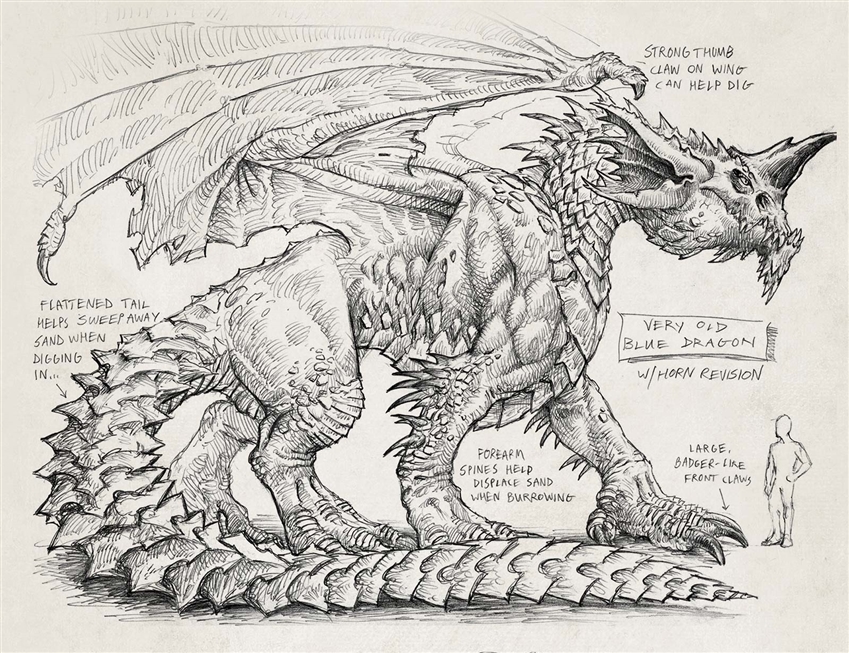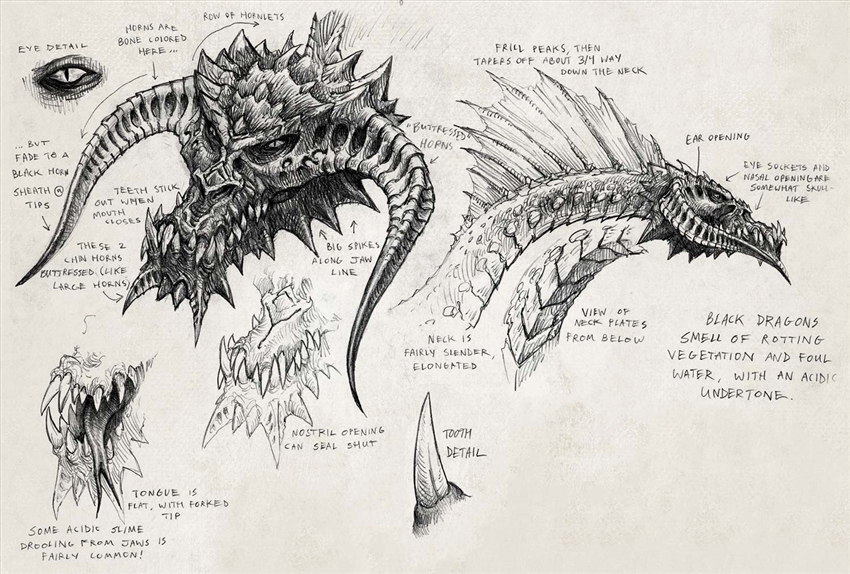Graxis was a powerful minotaur who was guarding the maze before the burial tomb of Xander "Dragonshield" Huorath. He attacked The Heroes of Thylea and successfully (if temporarily) killed Praxos. He finally confronted the heroes as they were about to Claim the Weapons of the Dragonlords and perished.
True dragons are winged reptiles of ancient lineage and fearsome power. They are known and feared for their predatory cunning and greed, with the oldest dragons accounted as some of the most powerful creatures in the world. Dragons are also magical creatures whose innate power fuels their dreaded breath weapons and other preternatural abilities.
Many creatures, including wyverns and dragon turtles, have draconic blood. However, true dragons fall into the two broad categories of chromatic and metallic dragons. The black, blue, green, red, and white dragons are chromatic. The brass, bronze, copper, gold, and silver dragons are metallic.
Though their goals and ideals vary tremendously, all true dragons covet wealth, hoarding mounds of coins and gathering gems, jewels, and magic items. Dragons with large hoards are loath to leave them for long, venturing out of their lairs only to patrol or feed.
True dragons pass through four distinct stages of life, from lowly wyrmlings to ancient dragons, which can live for over a thousand years. In that time, their might can become unrivalled and their hoards can grow beyond price.
Dragon Age Categories
Category | Size | Age Range |
| Wyrmling | Medium | 5 years or less |
| Young | Large | 6–100 years |
| Adult | Huge | 101–800 years |
| Ancient | Gargantuan | 801 years or more |
Red Dragons
Red dragons are vain, reflected in their proud, upright bearing and disdainful expression.
Their pupils fade as they age, until the oldest have eyes with the appearance of molten orbs.
An angry red may have flames licking up from eyes and nostrils—and an envelope of heat-shimmer around them.
Their frill and wings are an ashy blue or purple grey toward the edges, becoming darker with ages—nearly black on older specimens.
Reds smell like smoke and sulphur.
Blue Dragons
Blues are vain and territorial.
They are distinguished by their dramatic frilled ears and single, massive brow horn. They are also one of the best-adapted dragon breeds for digging into sand.
Their hides tend to hum and crackle faintly with built-up static electricity, and to emit small arcs of electricity. These effects intensify when the dragon is angry or about to attack.
They smell of ozone + sand.
Green Dragons
Green Dragons at various ages
Black dragons are evil-tempered, cunning, and, malevolent. Their crafty, sinister faces reflect this.
They are sometimes known as “skull dragons” for their deeply socketed eyes and distinctinve nasal opening. Adding to this impression is the gradual deterioration of the hide around the horn base/cheekbone. This does no harm to the dragon but increases with age.
Black Dragon Identifiers
White Dragons
Among the smallest and least intelligent of dragonkind, most white dragons are simply animalistic predators.
Their faces express a hunter’s single-mindedness and ferocity rather than the shrewdness and insight of the more powerful evil dragons.
Their beaked, crested heads are distinctive.
(A crisp, faintly chemical odor).
White Dragon Identifiers
A charmed creature can’t attack the charmer or target the charmer with harmful abilities or magical effects.
The charmer has advantage on any ability check to interact socially with the creature.
The Amazons are a warrior culture that emphasizes the strength of the individual, in contrast to societies that defend themselves with large armies of hoplites and mounted cavalry. A typical Amazonian conclave will outline its territory, usually an island, and fight viciously to drive away trespassers. When the territory is threatened, they may band together into war parties, whose collective battlecries are said to strike fear into enemies up to a mile away.
For millennia before the coming of the Dragonlords, the Amazons were there. Raiding and fighting the Gygan empire, they were amongst the most feared denizens of Thylea. Over the many century’s outsiders would occasionally wash up on the shores of Thylea. These were usually shipwrecked explorers or merchants who were blown far off course. Of all races and nationalities, these people had to live in harmony with the natives of Thylea. They formed tribes and lived on the islands of the Cerulean Gulf and for the most part coexisted with the Amazons.
When the Dragonlords came, some of the tribes fought with the natives of Thylea against the newcomers but some sided with the newcomers. The Amazons stayed on their own side, but while they were distracted by the infighting their forces were entirely shattered by the armies of the Titans who used the chaos of war as a way of finally getting rid of the Amazon threat.
Blaming their losses on the frailty of the other races who surrounded them, they sought to isolate themselves from the rest of Thylea and create a stronger society: a society dominated by Amazon warriors. Accordingly, they retreated to the remote island of Themis and established an isolated kingdom, unspoiled by the weakness of the other races. The Amazons define themselves as a sacred band of warriors who always stand together as a sisterhood. They train for combat from an early age, and once they come of age, they form into pairs of sister-warriors: lifemates. There are only a few thousand Amazons on Themis, but they are among the most feared warriors in all of Thylea—brutal berserkers with no mercy. They have been known to enslave prisoners, but most of them are executed.
Beastmasters
The Amazons domesticated some of the beasts on Themis. They use rhinoceroses as mounts, and they have trained the native basilisks to act as hounds. Most Amazon warriors keep clockwork birds, called stimfay, as loyal companions and scouts.
Always on the move
The Amazons don’t build any permanent structures on the island except for their prison. Instead, they travel across the island and make temporary camps, usually of 10-20 Amazons and rhino mounts. Each camp is prepared for surprise raids and skirmishes with the other camps. This perpetual “great game of war” is considered essential to the Amazonian way of life.
Sister-Warriors
The Amazons define themselves as a sacred band of warriors who always stand together as a sisterhood. They train for combat from an early age, and once they come of age, they form into pairs of sister-warriors: lifemates.
The innkeeper of The Sour Vintage is a retired hunter named Aetala. She knows the Heartlands better than most,
and she has all the rumours from Estoria. She recognizes
at least one of the heroes, and she suggests that they
hunt the boar. Aetala made her fortune-hunting a similar
beast decades ago.
The Antikythera is a complex construct that acts as a magical compass. It also has the power to mend damage to a ship: once per day it can magically repair 50 hit points of damage to a ship it is aboard. It uses the constellations to guide its user to islands in the Cerulean Gulf or Forgotten Sea. Every island in these seas are associated with a specific constellation. The Antikythera must be used on dry land as the constant movement of waves makes it impossible to calibrate. When it is calibrated to the proper constellations, it will show a path that can be used to reach the island associated with a particular constellation.

The Sideris family was notable for its contributions during the First War and their role in making the Academy of Mytros a reality.
Kyrah is revered as the trickster goddess of music, poetry and arcane magic. She is the swiftest of all the gods, capable of disappearing in the blink of an eye and she can travel great distances with each step. Her voice is said to be more beautiful than any musical instrument. There are very few shrines to her, except among bards, who revere her as the Muse.
Her symbol is a Silver-stringed lute with five stars.

Her symbol is a silver-stringed lute with five stars
Piety
Earning and Losing Piety
You increase your piety score to Kyrah when you expand the god’s influence in the world in a concrete way through acts such as these:
Pulling a prank on a figure of high standing
Telling a joke that makes a large crowd laugh or groan
Passing yourself off as another person
Beating someone in a foot race
Your piety score to Kyrah decreases if you diminish Kyrah’s influence in the world, contradict her ideals, or make her look ridiculous or ineffectual through acts such as these:
Bringing order in times of chaos
Being a boring person with boring ideas.
Telling the truth to someone you despise
Rank | Piety Needed |
Devotee | Piety 3+ |
Votary | Piety 10+ |
Disciple | Piety 25+ |
Champion of Trickery | Piety 50+ |
Tysophale was a Silver Dragon, Oathsword of Telamok Arkelander.












/src/notes/ecjRGXg1u8ULkzDTvWiKRT9iZgY4UVXQUYP3QWJF.jpg)






/src/characters/ewUYOizD1ynXJMXeQmydnJ82l5E5MGe71Tp9Crl4.png)

